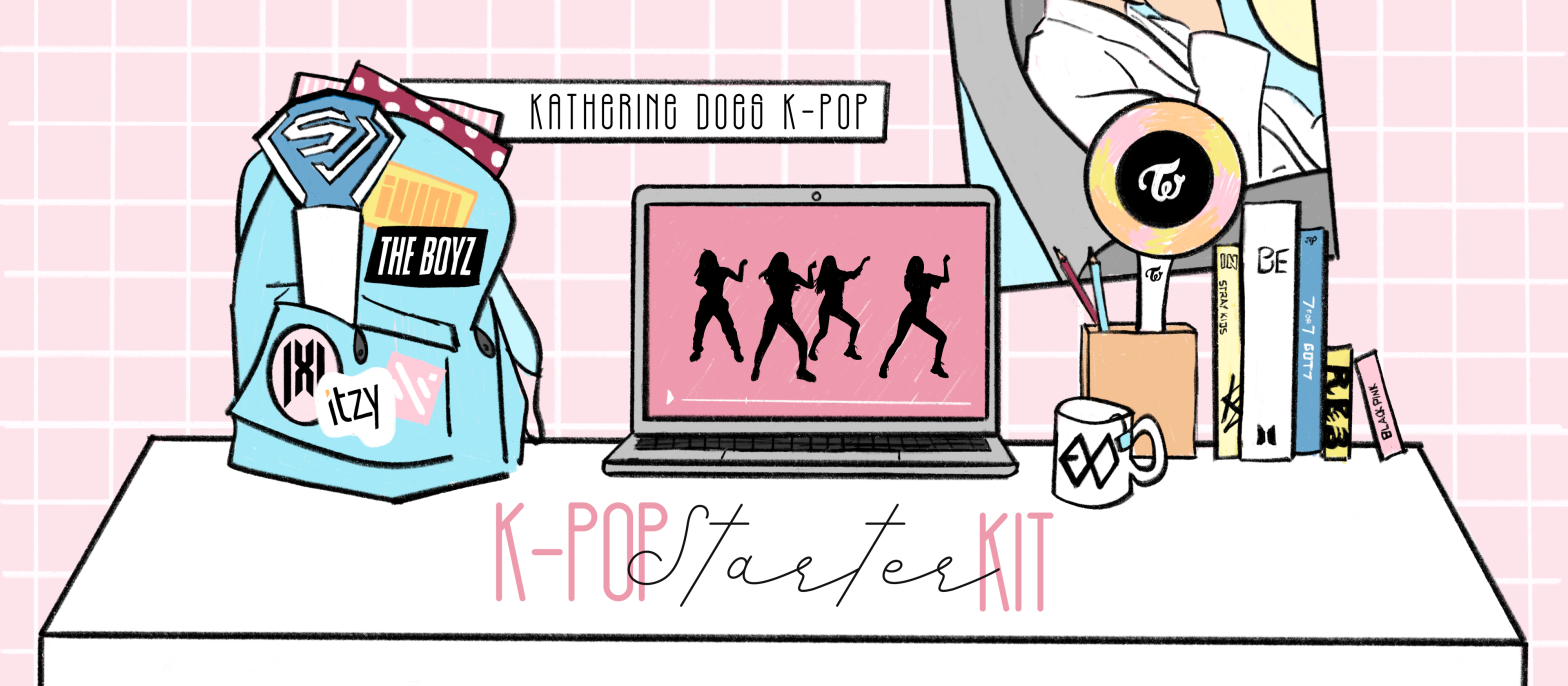Once you’re familiar with the basics of Hangul, you’ll start to notice a fair amount of Korean words are actually taken from English. It’s the same in K-pop, where many groups’ names have English origins. So since we’re moving from learning letters to making words, this post will show you how to read Hangul by looking at how some K-pop groups transcribe their names from English to Korean. I’m making a separate post about how to read Hangul with Korean names, but I chose to do this first since I assume most people reading this are K-pop fans, beginner level Korean learners, and/or English speakers. And if you’re just starting to study Korean, you might still be getting used to all of the different sounds and letters. So, I hope comparing the Korean and English versions of these groups’ names will help connect some dots.
The Usual Disclaimers
Please keep in mind that these posts are supposed to be a VERY basic introduction to Korean language. My Korean level is probably somewhere around intermediate, and I’m nowhere near fluent. Korean is a wonderful and fascinating language, but it’s also very complicated with many nuances that I’m either not aware of or don’t fully understand yet. I’m doing my best to share all that I know and have learned, but I don’t personally feel qualified to be giving formal and/or official lessons. Plus I’m an American learning Korean, so I can only provide you with my own experience and perspective – I certainly don’t have the same insight and knowledge as an actual Korean person. So I’ll only be writing about beginner level elements I can confidently explain, but I’d be happy to point you to some of my learning resources if you want to know more or start seriously studying.
I know I said before that you should minimize using Romanization as much as possible, but this is one of those times when you just can’t avoid it. This is a written post, so I can’t really show you how to read Hangul without throwing in the corresponding English spellings. But once you’re more comfortable with Hangul, I really do recommend phasing Romanization out as much you can.
Making Words in Hangul
Now that we know all of the Hangul letters, it’s time to start combining them to make words. Korean words consist of one or more syllables, and each syllable is written as a “block.” Each block contains two to four letters – there can be up to three consonants, but never more than one vowel. Here are the five different types of syllable blocks you can see in Hangul, along with some examples. (You don’t have to know what any of these words mean; I’m just trying to give you an idea of what Hangul looks like.)
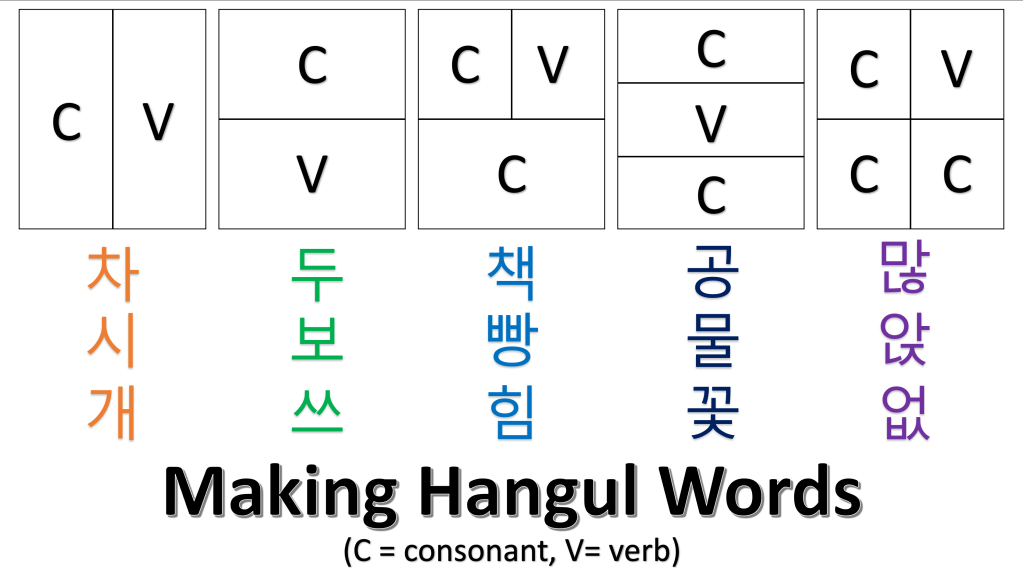
While reading and writing Hangul is generally pretty straightforward once you get the hang of it, there are a few important notes to remember:
- Consonants always come first in a syllable. While there are Korean words that are purely vowels, there’s a rule that vowels are never the first written letter in a block. This is where the unique consonant “ㅇ” sometimes comes into play, acting as a silent placeholder for where a consonant would normally be. For example, you can’t write “ㅜ” on its own since that’s just a letter – you have to add “ㅇ” over it to make the complete syllable “우.”
- There are two different ways of writing Hangul syllables: horizontally or vertically. However, stroke order for each individual letter is always from top to bottom, left to right.
- Horizontally (one row): The consonant is written on the left and pronounced first, followed by the vowel on the right. For example, “시” (city) is “ㅅ +ㅣ” and Romanized/pronounced as “si.”
- Horizontally (two rows): The letters on the top row are written and said before the bottom ones, all still from left to right. For example, “책” (book) is “ㅊ +ㅐ+ㄱ” and Romanized/pronounced as “chaek.” (See the note below to learn more about pronouncing four-letter syllables.)
- Vertically: If the vowel of the syllable is “ㅗ,” “ㅜ,” or “ㅡ,” then the letters are actually stacked from top to bottom. The consonant goes on top, with “ㅗ,” “ㅜ,” or “ㅡ” right below. They’re also pronounced that way: for example, “두” (two) is “ㄷ + ㅜ” and Romanized/pronounced as “du.” And if there’s a second consonant, it would go below those two and move the vowel to the middle. For example, “공” (ball) is “ㄱ+ ㅗ+ ㅇ” and Romanized/pronounced as “gong.”
- There are some syllables that have four letters, and there are two different ways of pronouncing them.
- If a four letter syllable finishes the word or sentence, or if it’s followed by a word that starts with a consonant, then you only pronounce the first three letters and NOT the fourth. For example, the verb “앉다” (to sit) is pronounced like “anda” while the fourth letter “ㅈ” remains silent.
- If a four letter syllable is followed by a word that starts with a vowel, then the fourth letter is pronounced like it’s starting that next word. For example, if someone says “앉으세요” (“Please sit down”), it will sound like “anjeuseyo” and you will clearly hear the “ㅈ.”
Reading K-pop Group Names
For this post, I have chosen ten K-pop groups whose names are either English words or originally made with English letters. (Sometimes K-pop agencies like to combine English words and make unique portmanteaus for group and fandom names.) There are two pictures for each group: the first shows their name in Hangul with brackets to highlight the corresponding English words and letters, and the second image is a more detailed breakdown that indicates which Hangul letters make up each syllable. Finally, there’s a notes section where I mention anything else I find interesting or important.
ATEEZ
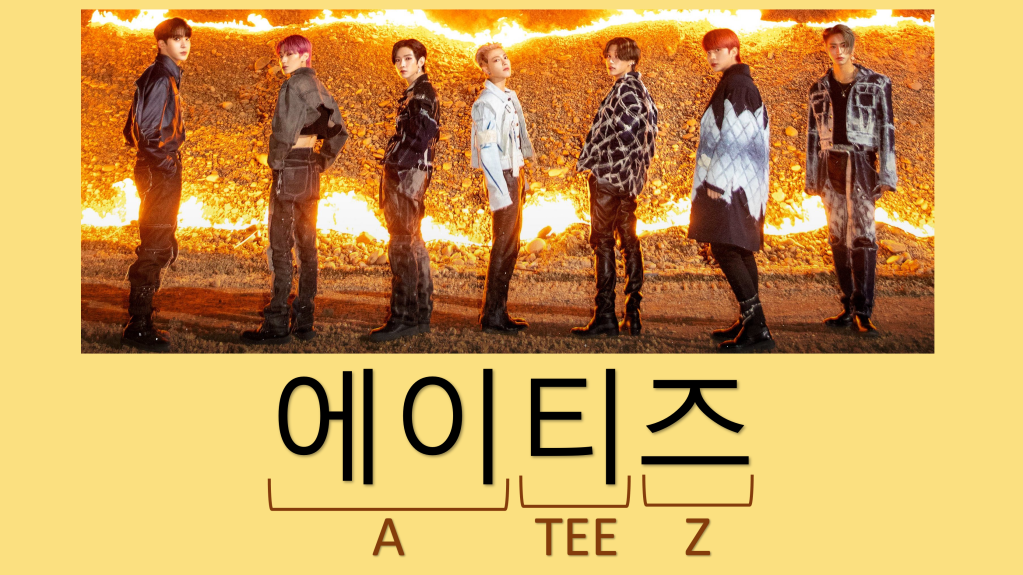
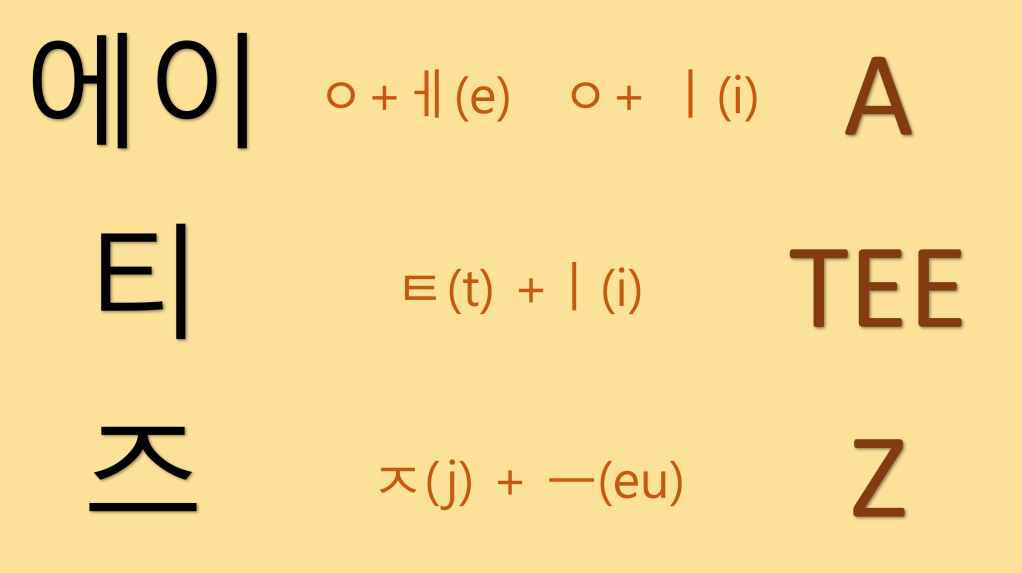
- Since the “a” sound is longer and flatter in English, it’s transcribed as “에이” instead of just “에.”
- Korean consonants usually aren’t pronounced as strongly as English ones. This is especially true when consonants are at the end of a word. So when it comes to converting English words or sounds, Koreans often add a vowel to pronounce everything distinctly. As we see with ATEEZ, that vowel is usually “ㅡ.” We will see plenty more examples of this throughout the post.
- The letter “z” doesn’t naturally exist in Korean, nor does the sound. Usually, “z” is replaced by “ㅈ” and makes more of a “j” sound. (Though some Koreans, especially those who have studied English, will pronounce “ATEEZ” with a “z” like in English.)
BLACKPINK
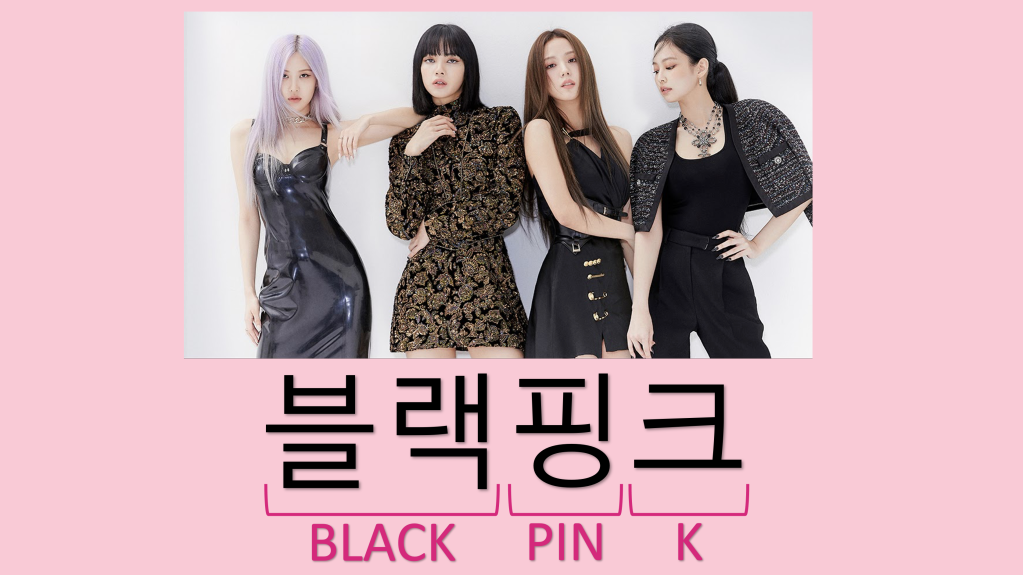
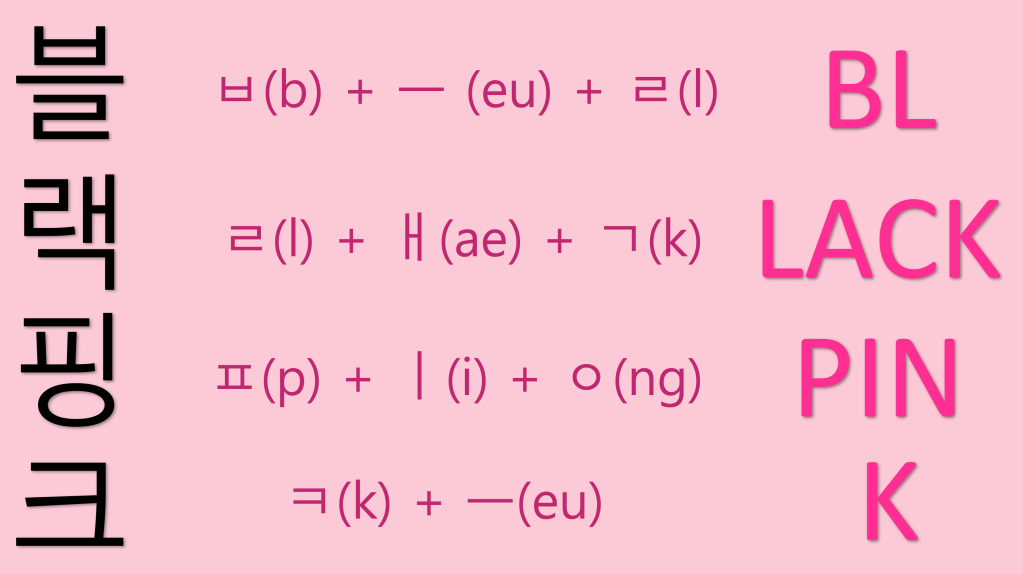
- In English, both “black” and “pink” are one syllable words. However, this isn’t natural in Korean – so the transcription makes both words into two syllables, once again using the vowel “ㅡ.”
- In Korean, words don’t usually start with two consonants together. So, a word like “black” would difficult to pronounce in one syllable. In this case, they separate “b” and “l” by adding “ㅡ” in between, making one syllable that sounds like “beul” and another that sounds like “laek.”
- Similarly, “pink” is changed into two syllables with “ㅡ” to make the “k” sound stronger.
ITZY
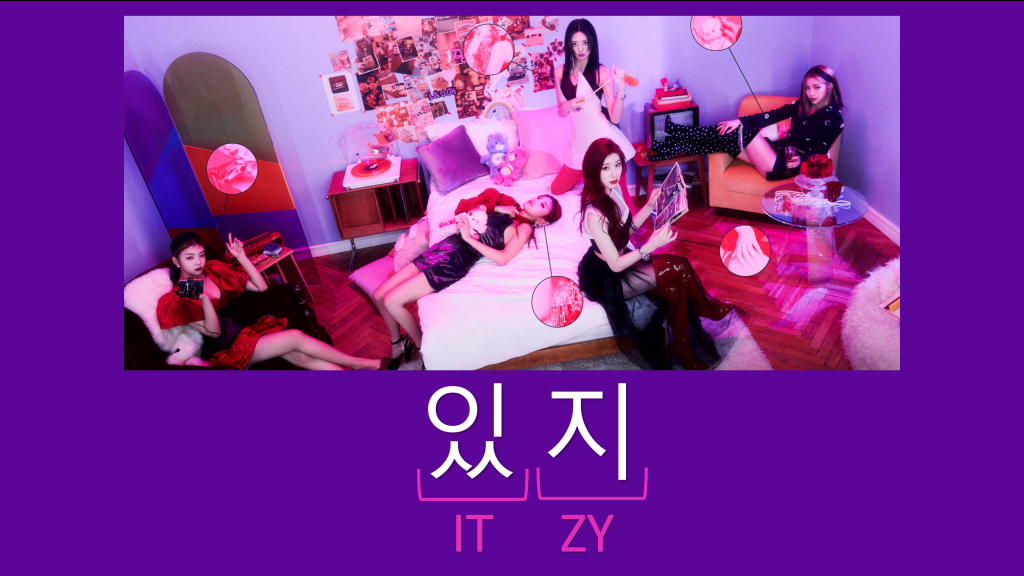
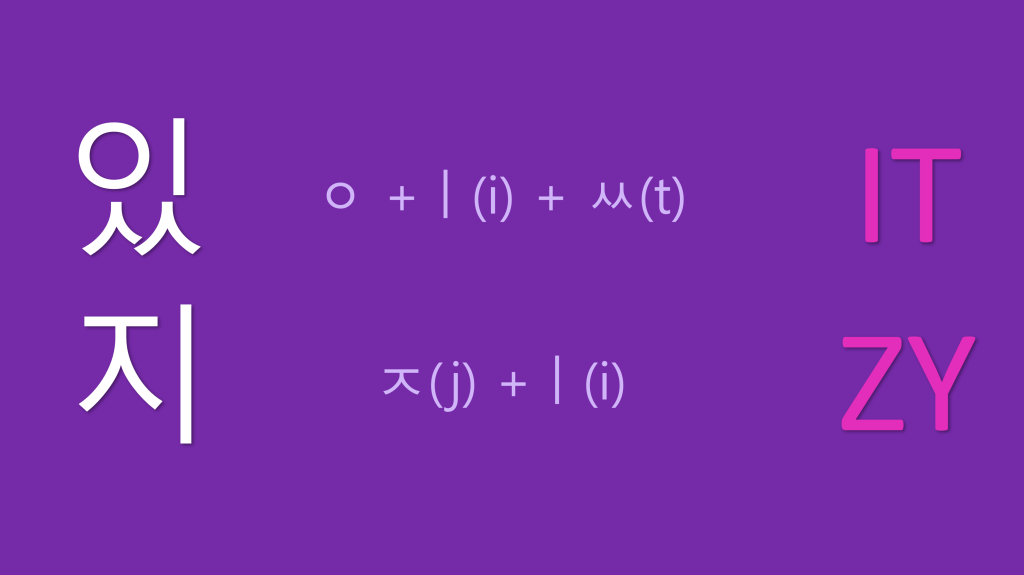
- In my previous post about consonants, I mentioned that “ㅅ,” “ㅈ,” or “ㅊ” are often pronounced as a soft “t” if they’re finishing a sentence or at the end of a syllable (unless the next syllable in the word starts with a vowel). This also applies to the double consonant “ㅆ.” In this case, “있” is followed by “지,” and “ㅈ” is another consonant. So here, “있” would be pronounced as “it.”
- Like we saw with ATEEZ, the letter “z” has been transcribed to “ㅈ” (j.) So although there are Koreans who use the English pronunciation – including ITZY themselves – there are some who say their name like “itji.”
Monsta X
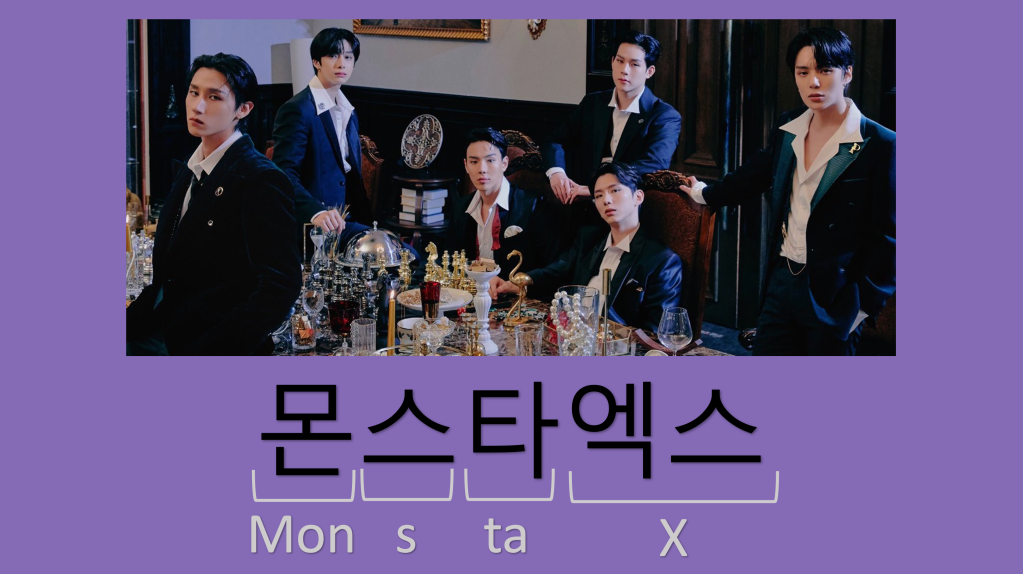
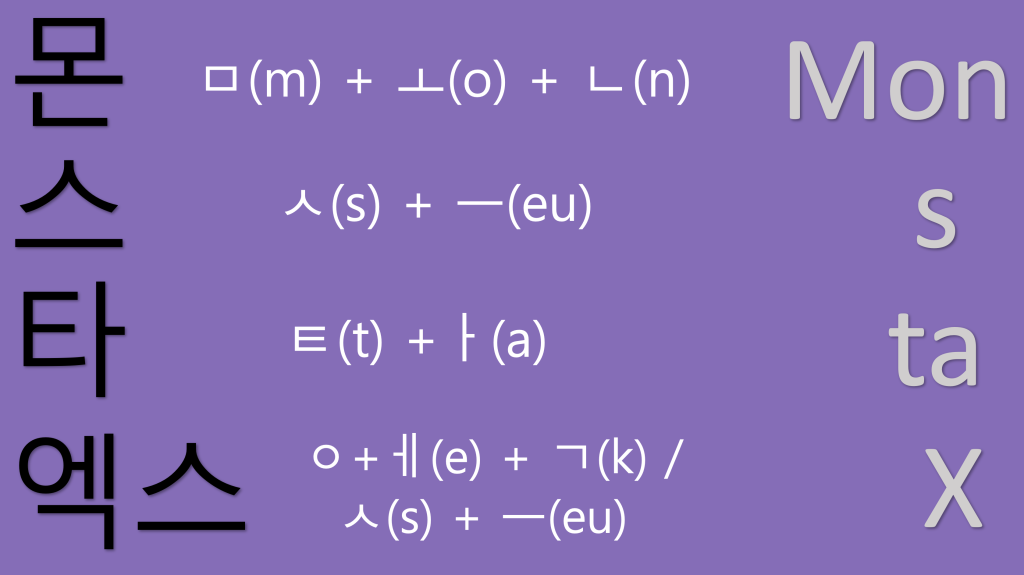
- “ㅡ” is added into “Monsta” to separate the “s” and “t” sounds and pronounce them more clearly. Also, this group’s name is supposed have the double meaning of “monster” and “my star” (which is “mon star” in French), which is why they chose the spelling “Monsta” and not the actual word “monster.”
- The English letter “x” is another one that doesn’t naturally exist in Korean, which is why it’s transcribed as “엑스” and Romanized/pronounced as “ekseu.” Similarly, fellow boy group EXO’s Hangul name is “엑소” and Romanized/pronounced as “ekso.”
Oh My Girl
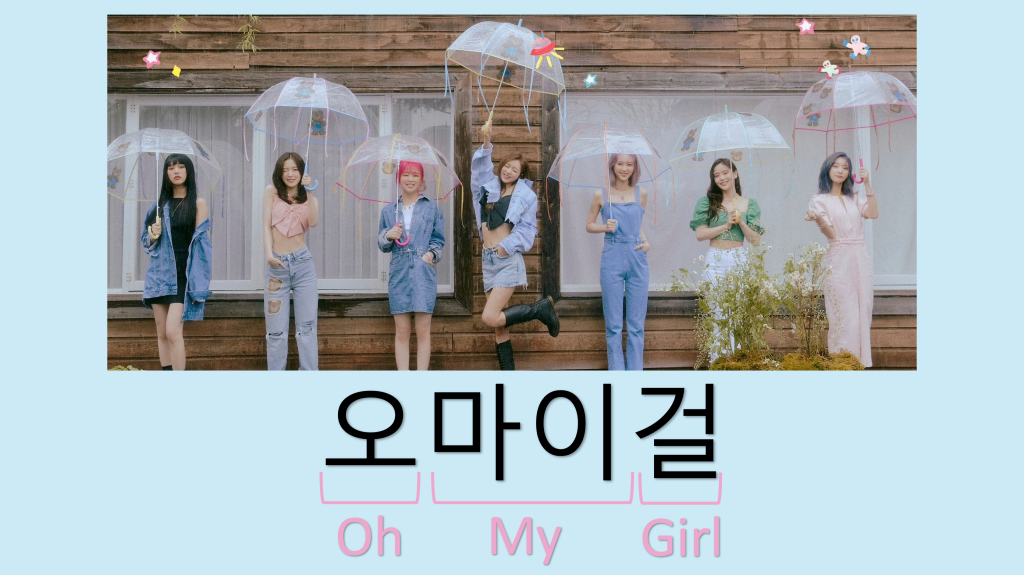

- While there is a Korean vowel that’s transcribed with the letter “i,” it’s always pronounced as an “ee” sound – the English “i” sound heard in words such as “hi” or “ice cream” doesn’t naturally exist. To make that “i,” Koreans use the two syllables “아” and “이” together. The “my” in “Oh My Girl” follows the same principle.
- The natural pronunciation of “ㄹ” is a sound somewhere between the English “l” and “r.” But since it’s at the end of the syllable, Koreans would say it as a full “l” sound. So to a native English speaker, “걸” might sound a little closer to the word “goal.”
Red Velvet

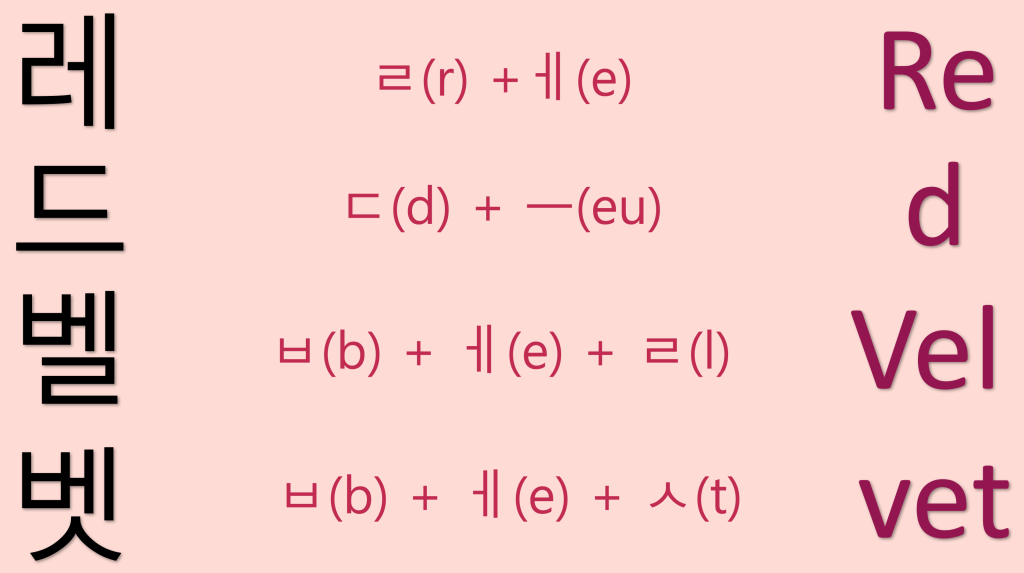
- “Red” is split into two syllables, adding “ㅡ” to make the “d” sound stronger.
- The letter “v” doesn’t naturally exist in Korean, nor does its sound. It’s often replaced with “ㅂ” and pronounced as “b.” (Though many Koreans, especially those who have studied English, say it with the “v” sound.)
- Since “벳” is the last syllable in the name, the letter “ㅅ” is pronounced as a soft “t” instead of “s.”
SEVENTEEN
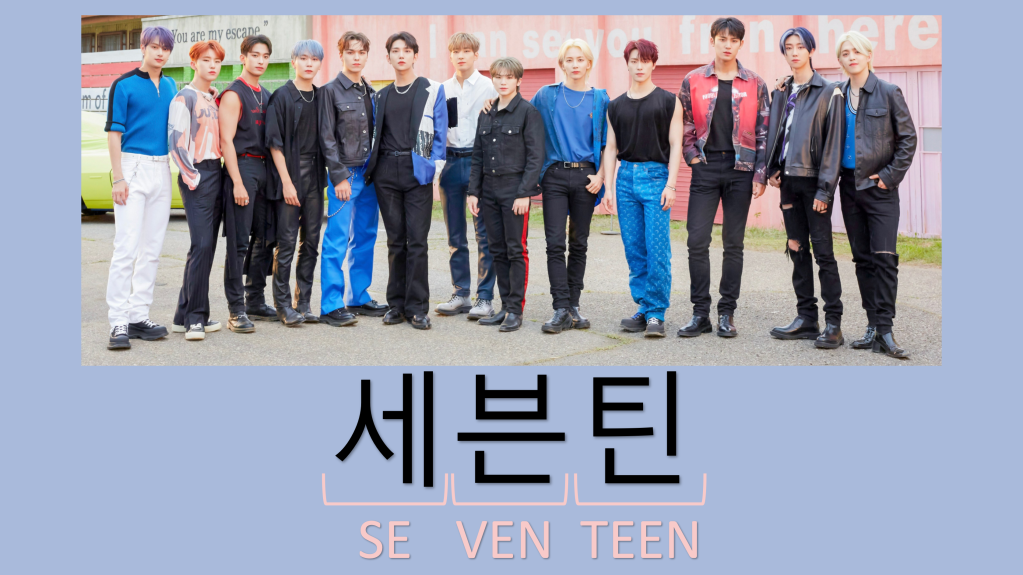
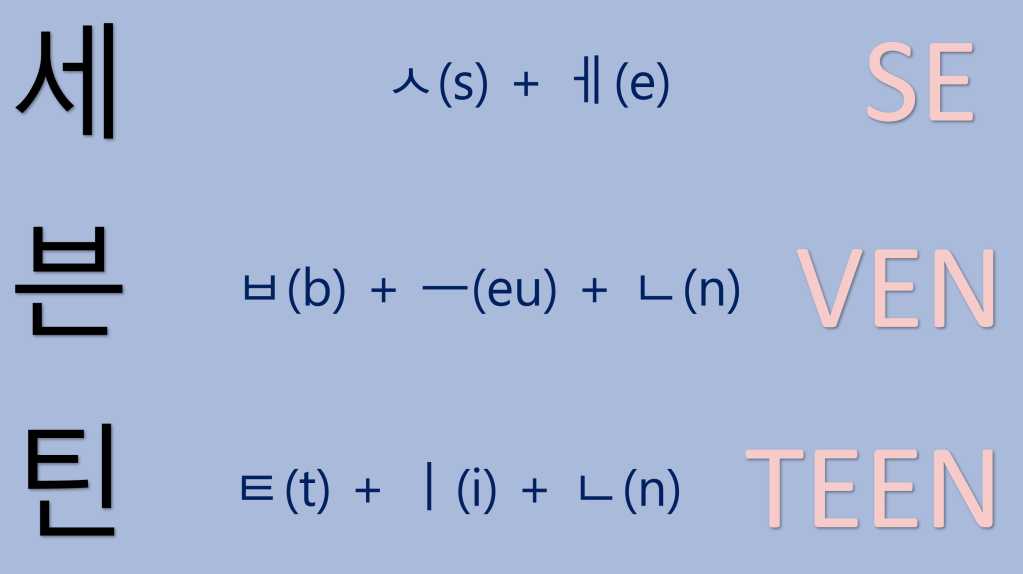
- This Hangul version is pretty straightforward and close to its English origins, so there’s nothing major to note!
Stray Kids
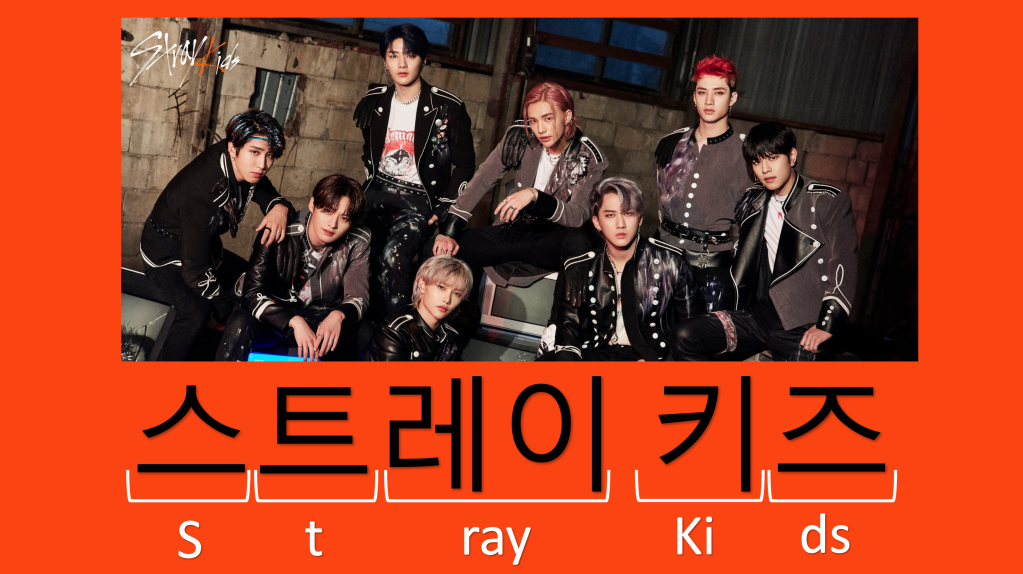

- While “stray” is one syllable in English, it’s four in the transcribed Korean version.
- The Hangul breaks up “stray” so that each consonant is its own syllable, adding “ㅡ” to help emphasize the “s” and “t” sounds.
- Like ATEEZ, it also puts the sounds “ㅔ” and “ㅣ” next to each other to make a long “a” sound.
Super Junior
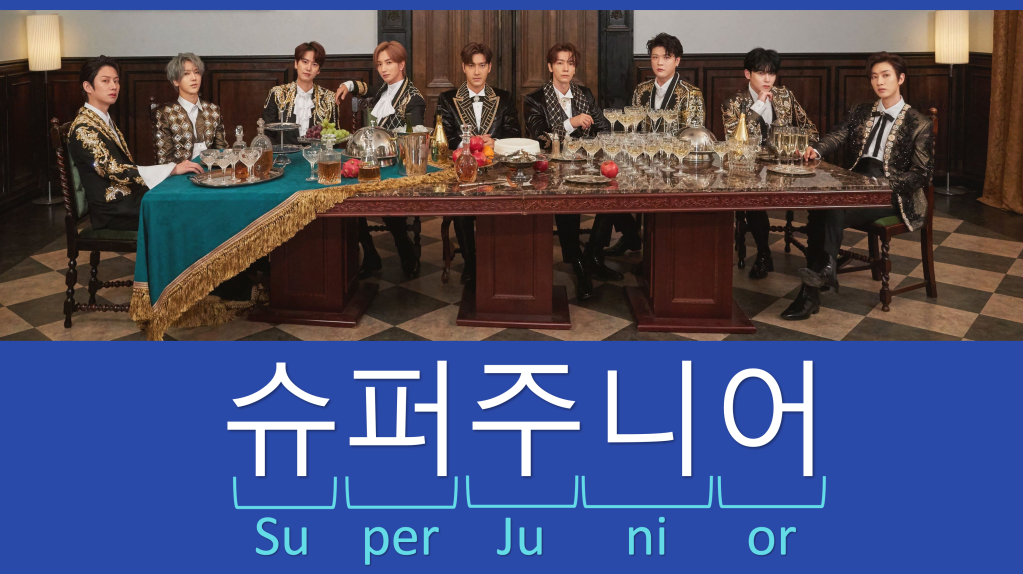

- Honestly, I have no idea why they use “슈” instead of “수.” (The members themselves often pronounce it with that “sh” sound, too.) If anyone reading this knows the answer, feel free to chime in!
- Although “Junior” ends with an “r” in English, the transcription leaves it off and goes with “어.” (I think it’s because if it was “얼,” it would sound more like “l” instead of “r.”) This is also the same for other groups who have “er” in their name – like Dreamcatcher, Tomorrow by Together, etc.
TWICE

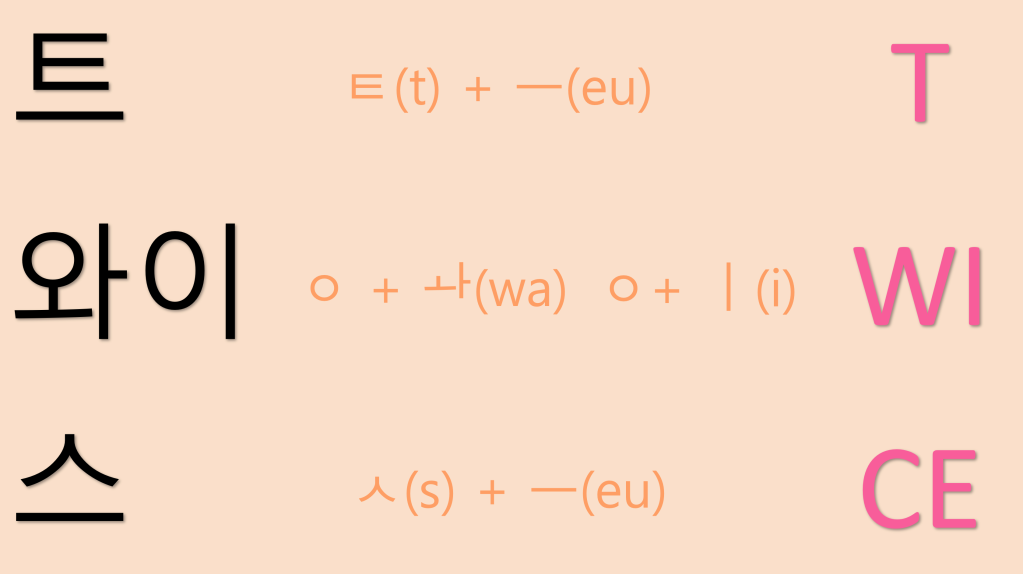
- “Twice” is one syllable in English, but becomes four syllables when transcribed in Korean:
- The vowel”ㅡ” is put between “t” and “w” to make the “t” sound stronger.”
- Also, it’s worth noting that “w” isn’t a consonant in Korean the way it is in English – you only hear it when combining certain vowels together to make complex vowels.
- The “i” sound is made by putting “ㅏ” and “ㅣ” together. (Or in this case, ” ᅪ” and “ㅣ.”)
- Since “s” is not usually an ending sound in Korean, it’s turned into its own syllable with “ㅡ” to make the pronunciation more distinctive.
NOTE: The featured image is a custom design I requested from my friend specifically for this blog and this column. Please do not alter it, repost it, or re-upload it without my permission. If you want to see the artist’s work, you can go to to her Instagram account here and/or her website here.
I made the other images in this post through PowerPoint. The pictures of the groups don’t belong to me, and I credited their image sources. But the layout and formatting is my own work, so please don’t repost or upload these images without my permission either.
GROUP IMAGE SOURCES:
ATEEZ: KQ Entertainment (teaser photo for “Fireworks (I’m the One)”)
BLACKPINK: Twitter – original tweet here (teaser poster for their online concert The Show)
ITZY: JYP Entertainment (teaser photo for “In the Morning”)
Monsta X: Starship Entertainment (teaser photo for “Gambler”)
Oh My Girl: WM Entertainment (teaser photo for “Dun Dun Dance”)
Red Velvet: SM Entertainment (teaser photo for “Psycho”)
SEVENTEEN: Twitter – original tweet here (taken during “Ready to Love” promotions)
Stray Kids: JYP Entertainment (teaser photo for “Back Door”)
Super Junior: SM Entertainment (teaser photo for The Renaissance)
TWICE: JYP Entertainment (teaser photo for “Alcohol-Free”)

